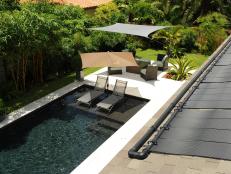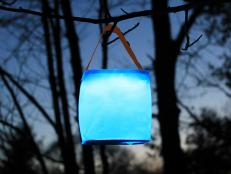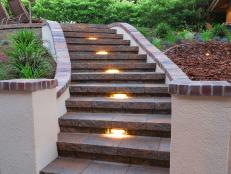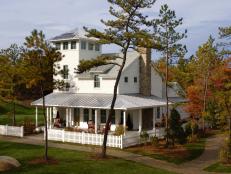Low-Voltage and Solar Lighting
Low-voltage and solar lighting are excellent choices for outdoor lighting because they’re effective, easy to install and environmentally friendly. Low-voltage (12-volt) lighting is safer than 120-volt systems because the low level of energy eliminates the possibility of electrocution from accidentally cutting the cabling. It’s also more efficient, providing more light per watt of power, and the bulbs last longer than the incandescent lamps typically used with a 120-volt system. A low-voltage system requires specific light fixtures, cabling, electrical access and a transformer to reduce the 120-volt house current to the 12 volts required by the fixtures.
Solar lighting systems have stand-alone fixtures with built-in solar panels and batteries to collect and store the sun's energy to power the light. These systems are a bit easier to install and rearrange than low-voltage systems because solar systems don't require electrical access or cabling. A solar lighting system will work well as long as it receives the amount of sunlight recommended by the manufacturer to fully charge the batteries. Less-than-optimal battery charging will shorten the battery life, and the batteries in some systems are not replaceable. For landscaping that doesn't receive sufficient sun time to power dispersed individual solar lights, use a single, stationary solar panel optimally positioned to collect solar energy.
Creating an effective lighting system is both an art and a science. Here's how to do it:
Determination of Lighting Needs
The most popular reasons for having exterior lighting are security, safe movement and decoration. View the home's exterior in daytime and at night and think about the functionality of each area. Then use various techniques such as uplighting, downlighting and path lighting for interest. You don't need to have high levels of light coming from individual fixtures; instead, use several fixtures at lower wattages for a professional-looking effect. Also, be sure to locate fixtures so they won't interfere with traffic or lawn mowers or create an irritating glare inside your home or for your neighbors.
Selection of Lighting System and Fixtures
For areas near the house with easy electrical access, you may want to use a low-voltage system. For lighting areas farther from the house, a solar lighting system with no cabling may work best.
When using a low-voltage system, you'll need to select a transformer, controls and cabling, in addition to the light fixtures. Here are tips to help you choose:
- Transformers are available from 60 to 1,120 watts in above-ground cases and direct-burial models. Calculate the size of transformer you'll need by multiplying the number of fixtures by the wattage of each fixture the transformer will serve. For example, 12 fixtures at 20 watts need a transformer to be 240 watts, minimum. It’s wise to choose a transformer that may be a little more powerful than you'll need at the outset to allow for an increase in lamp wattage or adding fixtures later. For large projects or to control lights in different areas independently, use multiple transformers.
- You can install controls to turn the transformer on and off automatically. Photocells can be used to turn transformers on at dusk and off at dawn. To save energy and avoid resetting for daylight-savings time, use a timer and a photocell together to turn the transformer on at dusk and off at a preset time during the night.
- Lighting cable is available in several gauges; 12-, 10- and 8-gauge are most commonly used for outdoor lighting. For longer runs, you may want to use a lower-gauge cable (8 rather than 12) to avoid excessive voltage drop, which results in dim lights at the end of a cable run. Using a hub layout will also help avert excessive voltage drop. In a hub layout, each fixture has a connection to the transformer without passing through another fixture.
For a solar lighting system, the positioning is the most important consideration. It's better to use fewer lights spaced closer together (10 feet at most) than to use more lights spaced farther apart. Consider using clusters of lights when highlighting a door or other feature. When lighting a walkway, driveway or other pathway, avoid the "airplane runway effect" by alternating and staggering lights on either side of the path.
Once you've determined the type of lighting and the positions, select the specific fixtures for each application. Low-voltage and solar outdoor light fixtures are available at hardware, lighting and discount stores and online. A wide variety of colors, shapes, sizes and styles can meet a range of illumination needs and suit personal tastes. For fixtures with high visibility, choose colors that best complement the home's exterior design and landscape theme, such as antique or polished copper, pewter or brass. For lighting that you want to blend in with the surrounding foliage, choose fixtures that are verdigris or black.
Installation
For systems that involve cabling, lay cabling on top of the ground first to ensure the correct route. Next, bury the cabling just below the surface; it's easiest to use a lawn edger to score the ground through mulched or gravel-covered landscape areas. Connect the fixtures and bury the cabling with mulch or gravel. For stand-alone individual solar fixtures, simply push them into the ground in the designated locations. Once all lighting has been installed, view it at night and make any necessary adjustments, perhaps to fixture locations (slightly closer or slightly farther apart) or fixture angles (in the case of spots and floods). If an area is underlighted or overlighted, add or remove fixtures as needed.
Maintenance
Ongoing maintenance will keep the system looking good and functioning properly. Cleaning the lighting is important, especially the solar panels, because the presence of bird droppings or dirt on the panels can prevent optimal battery charging. For specific cleaning and maintenance directions, follow the lighting manufacturers' recommendations.









































